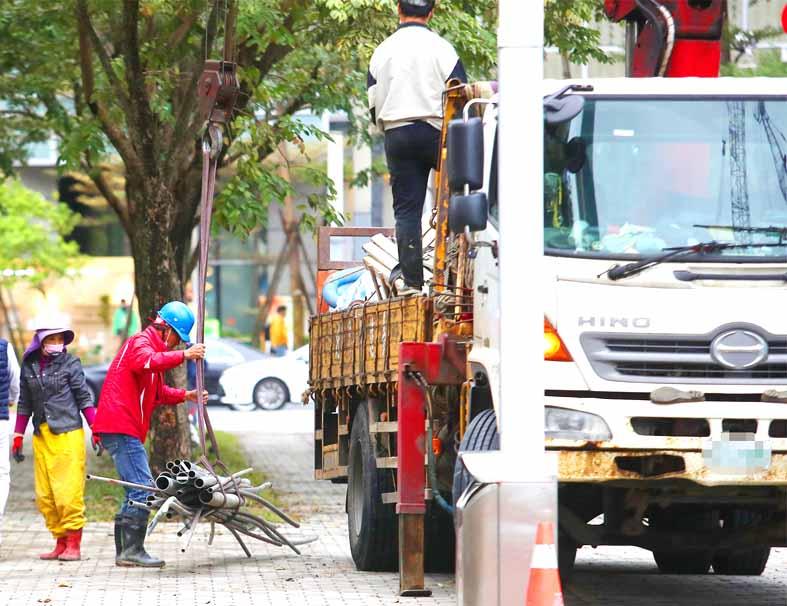The unemployment rate last month eased to 3.66 percent, the lowest since 2001, as the job market recovered further after a COVID-19 outbreak in May, although there is still room for improvement, the Directorate-General of Budget, Accounting and Statistics (DGBAS) said yesterday.
Last month’s figure was 0.17 percentage points lower than a month earlier, marking a fifth straight month of decline, DGBAS Deputy Director Chen Hui-hsin (陳惠欣) told a news conference in Taipei.
The unemployment rate is expected to decline again this month as retailers are hiring temporary staff to cash in on the holiday season, she said.

Photo: CNA
“Unemployment data nearly dropped to the level prior to the COVID-19 outbreak, but a considerable number of people are still working fewer hours,” Chen said.
The number of people who worked fewer than 35 hours per week stood at 229,000, 30,000 more than in previous Novembers, although the figure dropped by 64,000 from October, she said.
The jobless rate after seasonal adjustments stood at 3.71 percent, a decrease of 0.13 percentage points from a month earlier, the DGBAS said in a report.
The number of unemployed people totaled 436,000, a 4.38 percent decline, as people who lost jobs due to business downsizing and closures fell by 8,000, it said.
Meanwhile, the number of first-time jobseekers and people who quit their jobs both dropped by 4,000, it added.
By measure of the employed population, there were 47,000 fewer jobs available than before a level 3 virus alert was introduced in May, Chen said.
University graduates had the highest unemployment rate at 5.14 percent, followed by high-school graduates at 3.48 percent and people who completed junior high at 2.68 percent, the report found.
The unemployment rate for people with graduate degrees was 2.63 percent, the DGBAS said.
Demographically, people aged 20 to 24 had the highest unemployment rate at 12.19 percent, followed by people aged 15 to 19 at 8.62 percent and those aged 25 to 29 at 6.23 percent, it said.
The unemployment rate for people aged 30 to 39 was between 2.8 percent and 3.57 percent, while for people aged 45 to 64, it was 2.2 percent, the lowest, the DGBAS said.
However, the period of unemployment increased to an average of 20.4 weeks for all people and 23.3 weeks for first-time jobseekers, it said.
Taiwan’s headline unemployment rate is lower than Hong Kong’s 4.1 percent, but higher than Japan’s 2.7 percent and South Korea’s 2.6 percent, the DGBAS said.

CHIP RACE: Three years of overbroad export controls drove foreign competitors to pursue their own AI chips, and ‘cost US taxpayers billions of dollars,’ Nvidia said China has figured out the US strategy for allowing it to buy Nvidia Corp’s H200s and is rejecting the artificial intelligence (AI) chip in favor of domestically developed semiconductors, White House AI adviser David Sacks said, citing news reports. US President Donald Trump on Monday said that he would allow shipments of Nvidia’s H200 chips to China, part of an administration effort backed by Sacks to challenge Chinese tech champions such as Huawei Technologies Co (華為) by bringing US competition to their home market. On Friday, Sacks signaled that he was uncertain about whether that approach would work. “They’re rejecting our chips,” Sacks

NATIONAL SECURITY: Intel’s testing of ACM tools despite US government control ‘highlights egregious gaps in US technology protection policies,’ a former official said Chipmaker Intel Corp has tested chipmaking tools this year from a toolmaker with deep roots in China and two overseas units that were targeted by US sanctions, according to two sources with direct knowledge of the matter. Intel, which fended off calls for its CEO’s resignation from US President Donald Trump in August over his alleged ties to China, got the tools from ACM Research Inc, a Fremont, California-based producer of chipmaking equipment. Two of ACM’s units, based in Shanghai and South Korea, were among a number of firms barred last year from receiving US technology over claims they have

BARRIERS: Gudeng’s chairman said it was unlikely that the US could replicate Taiwan’s science parks in Arizona, given its strict immigration policies and cultural differences Gudeng Precision Industrial Co (家登), which supplies wafer pods to the world’s major semiconductor firms, yesterday said it is in no rush to set up production in the US due to high costs. The company supplies its customers through a warehouse in Arizona jointly operated by TSS Holdings Ltd (德鑫控股), a joint holding of Gudeng and 17 Taiwanese firms in the semiconductor supply chain, including specialty plastic compounds producer Nytex Composites Co (耐特) and automated material handling system supplier Symtek Automation Asia Co (迅得). While the company has long been exploring the feasibility of setting up production in the US to address

OPTION: Uber said it could provide higher pay for batch trips, if incentives for batching is not removed entirely, as the latter would force it to pass on the costs to consumers Uber Technologies Inc yesterday warned that proposed restrictions on batching orders and minimum wages could prompt a NT$20 delivery fee increase in Taiwan, as lower efficiency would drive up costs. Uber CEO Dara Khosrowshahi made the remarks yesterday during his visit to Taiwan. He is on a multileg trip to the region, which includes stops in South Korea and Japan. His visit coincided the release last month of the Ministry of Labor’s draft bill on the delivery sector, which aims to safeguard delivery workers’ rights and improve their welfare. The ministry set the minimum pay for local food delivery drivers at